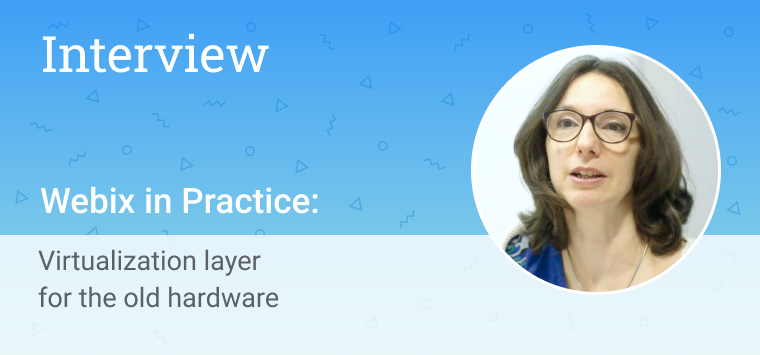We are happy to have one more Webix user ready to share his impressions on our product.

Today we are talking to Anders Rehnvall. Anders is an experienced developer and programmer fully devoted to his job. Currently he is the CEO and system architect at eze System, Inc. (www.ezesys.com). The company works in the Internet of Things space. They develop a hardware device that connects to industry standard sensors and equipment and monitors real-time data.
Hello, Anders! Nice to see you. Could you please introduce yourself for us? What is your IT related career?
Hi! Nice to see you too. Well, my interest has always been distributed system design, mixing real-world hardware with communication systems, data management and making these complex systems accessible for a broad audience. I worked in the electronic security industry for over 15 years, when the world shifted from dial-up services to always-on Internet, and moved me from desktop development to cloud-based applications. Initially the browser support for complex JavaScript wasn’t great, so I did a lot of back-end programming until around 2006 when jQuery came out, which was the key for me to work with front-end and back-end as one application.
Any remarkable milestones?
I’m proud that my company eze System is growing and already has thousands of active systems all over the world, monitoring and controlling everything from oil wells and gen-sets to irrigating farms and supervising water treatment systems.
Another achievement was the security system I was working on in the early 2000’s which is still in use in millions of homes in the US.
And here’s a funny story. In the mid-90’s me and my friend went on a vacation in Spain and France. I had a web page to where we posted real-time updates from our Nokia soap-bar phones via SMS. So we were ‘tweeting’ around 10 years before Twitter was conceived!
That’s cool! Tell us please about eze System and your role in the company.
I co-founded eze System with two partners in 2009. I am the CEO and system architect.
Eze System provides a unique system for remote monitoring and control of distributed equipment and machinery. The California company was founded in 2009 and now has thousands of systems all over the world. The second generation of the ezeio system is now being launched, which helps our customers scale up faster and further improve efficiency in their operations, saving energy, maintenance costs and having better data for business intelligence. The new system has improved account and user management, mapping features and computing capabilities. Our ezeio® controller is a hardware device that connects to industry standard sensors and equipment. It communicates via cellular networks and is managed from our cloud portal. The ezeio monitors data in real-time, allows for remote control, alarming and automation functions. The portal – using the Webix JavaScript UI framework – allows easy access to one or thousands of field devices for configuration and management.

Our system is cost-efficient enough for simple applications like temperature monitoring, but at the same time so powerful that it can be used in place of industrial controllers (PLCs) to run complex processes – all with full remote access to both data and configuration.
How big is the company?
While we have global clients and a sister-office in Europe, we are a small company. There are three developers in our team. I’m the system lead moving between hardware, firmware, back-end and web. I would say all three of us touch Webix every day, but we have one guy dedicated to only Webix development, quickly becoming our expert.
Tell us a little more about your product. Why did you decide to develop it?
After working on security systems for many years, I wanted to design something that was more interactive. A security system is typically silent until there is an issue to report, but using similar technologies I saw an opportunity to make something that you wanted to interact with – rather than hoping it would never go off.

Our system is unique, as it’s a multi-purpose system that is competitive both with functionality and price to custom designed and single purpose systems. Most remote management systems are either single purpose or they require significant adaptation or customization to be deployable at scale. Our system works out-of-the-box, and can be easily adopted by a wide range of industries and applications.

At the beginning it was a device that you connected to electric meters that monitored electric usage and created simple reports from that. From there we realized we could do more than energy monitoring. We started monitoring other things: flows and levels for such industries as water management, agriculture, oil and gas. We also started controlling equipment with the same systems, so we were able to receive data and send out control commands and update logic in the units. From there the company started blooming out, we grew to 4-5 people. About 3 years ago we realized our platform needed a refresh. We needed something more modern and more capable. That’s when we started using Webix. I needed something to quickly wire frame the functionality. I looked for a short learning curve to be able to quickly prototype different UI elements to work with. What I really like with Webix is that I got it right away. It was like jQuery+++! It got me going so fast! That became a big driver for me. Obviously we are a cloud system, but I wanted it to look like a desktop application. With Webix everything was one big JS file. I loaded it and I had all the resources I needed. I managed to quickly get into it, start creating forms, environments and navigation within the system. So for us it could not compete against anything else.
Are there many competitors in your field?
We work in the Internet of Things space, which is a massive market. There are a lot of segments within it. Many solutions are application specific. One part of them is a big industry for customized solutions. Such as fridge alarms, for example. They monitor fridges only, they don’t do any control or automation. On the other side there are big dragons, like Schneider Electric or Siemens, which offer consultant services. They ask their customers about their needs and start a whole new product from scratch.
We are somewhere in the middle. We have a standard hardware, compatible with other devices. The user of our product can set up everything in the back-end. They navigate our UI by themselves. We take care of the security aspect, the data storage and the communication side. When you use our product, you buy a little box, plug it in and start working with it on the web UI. So we differ from the traditional IoT, as we are not application specific, nor consultancy based. Our typical client is a mid-sized company, something between 20 and 2000 people, not big enough to develop their own IoT solution, but in need of something to work with their equipment. That’s where our product comes in.
It is interesting for us to know your opinion since you deal with IoT. What do you think Webix should have to attract the IoT developers?
The good thing is that Webix offers a client side package. There is no confusion between back-end and front-end. I really appreciate it. Webix states that jQuery is essential to work with it. But what I have noticed is that Webix replaces jQuery. There is something I’d like to make better about your library though. I mean selectors here. In jQuery, for example, you can choose controls based on CSS style or tags. I sometimes miss this feature in Webix. Selectors in jQuery are super powerful. From the IoT perspective, everything we do is cloud based and Webix fits 100%. Some IoT solutions have web server built into the hardware. I don’t know if Webix licensing module would work there. But it might be something to think of if you want to sell Webix that would run on distributed hardware.
What are the plans of your company for the future?
We are focusing on new features and reporting and analytics capabilities of our portal. As the hardware and firmware is now stable and in full production we can focus on the software features. Our next major project is some form of configurable report generator. We’re considering re-using the dashboard in a headless server-side process and feeding it through a PDF generator.
How did you learn about Webix?
Well, I was late night googling and just stumbled on it. It was a random find. I started experimenting with Webix for prototyping our second-generation system, which is a complete re-write from the previous system. Our lead software developer also evaluated Webix vs KendoUI and Extjs, and we soon agreed to use it as the learning curve was much shorter than for example the one of the Extjs.
Webix team are taking efforts to improve our product every day, so any feedback from the customers is very valuable for us. Can you mention any difficulties you had while working with Webix?
Over the three years that we are using Webix, there have been a few minor bugs. For example, the scroll view didn’t work the way we intended. But usually we find workarounds to make things work again.
One thing I would lift up was the inconsistency between JS and CSS packages. Especially when we were using the skin builder. Our idea was to use the skin builder to quickly rebrand the UI for various customers. Change the colors or the logo a bit for example. We are a cloud solution, so we have one platform. But depending on who logs in we want to customize everything a bit. We thought we could use the skin builder to come up with the templates for the customers or even let them design their own schemes. When the JS package was updated, the skin builder wasn’t following at the same time. So we ended up with some instances where the skin builder and the JS package caused a conflict. But actually it seems that you have addressed that, because we haven’t seen those inconsistencies any more. That was probably the biggest issue we have ever had with Webix.
Did you report the bugs to our support service?
We have used the forum for minor things. And I should say that when I ask something, there is always somebody to help me, either from the Webix team or just a user from the forum. So what I want to say is that the forum is very active and hugely valuable. There is a lot of information and it’s undoubtedly a great plus. Besides, I have used the ticketing system once or twice and I also got good answers there.
Have you used any complex widgets? Such as Kanban, Pivot, Spreadsheets.
Our UI is very form heavy. We are using it as a management and configuration tool for the hardware. The hardware dictates what the product does. Our customers buy a small box and plug it into their equipment. So the box has tens of thousands of configuration points. There are lots of things you can configure and program there. So we are heavy on using the form controls. We are using everything from push buttons to some graphical elements, such as sparklines to illustrate the data. Everything is live and updated in the background. When something changes in the field, you can see that in the UI. The most complex widget that we are using is the dashboarding feature. We use dashboards with panels and build the whole thing around them. So we can plug in any application within those panels. We haven’t started using any complex widgets yet, but they will definitely come in handy one day for us.
We are looking for new ideas right now. Maybe you have something on your mind on how Webix can improve?
Yes, there is one thing that is coming up for us. We need to build the report generator. We already have a pretty complex dashboard with the ability to build in any functionality. And now we are looking for various ways to make it a static report, run it on the server’s side and generate PDF files out of it. Some support for report generation would be helpful for us. I can even ask my colleagues to share their ideas on how it would be better to make that.
Do you use other UI libraries inside your solution?
We use Google maps for locating things. We also use ACE editor and other graphing libraries to make things more interactive, to zoom in and out, to handle more points faster. We would like to be more configurable with the gage control. The gage in Webix is very basic. It doesn’t have much control on how you can add marks, tick marks or put the numbers. We use a more configurable gage control. We are looking to have text and numbers, to control whether it goes from side to side, to be able to turn it, or twist it, or make it linear. We lack those features in Webix. We couldn’t have the graph that was interactively loading more data as we were moving it around.
Do you use Webix Jet?
It is easy for me to work with json directly and I don’t need anything else.
That was a very interesting conversation for us. Thank you for your time. Have a good day!
The free online CSS code beautifier takes care of your dirty code and strips every unwanted



